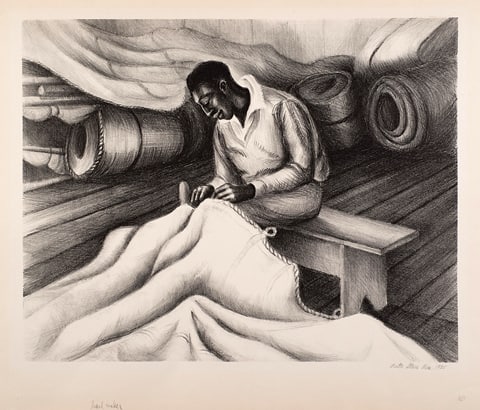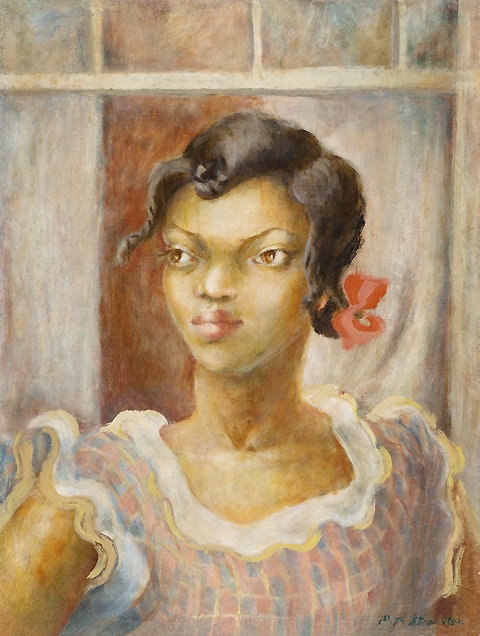How They Lived
On Maryland’s Eastern Shore, Ruth Starr Rose believed she had been “suddenly transplanted into a fairy world.”
After Wisconsin, rural Talbot County under the dominating influence of Chesapeake Bay must have been quite the surprise. Certainly her mother was taken aback by their new home, Hope House, a run-down Georgian mansion and tobacco plantation that had belonged to General George Washington’s aide de camp Tench Tilghman. She had gotten nothing much more than a view, a stairway and a cemetery, Ida Starr lamented upon their arrival.
Local carpenters, cooks, gardeners and other laborers flooded in to restore and maintain the home and farm.
The young artist, 19 when she came to Maryland, grew to womanhood amid that extended family. She sailed a log canoe, the Belle M. Crane, taught Sunday School at the DeShields African Methodist Episcopal Church and organized socials and explored the intellectual and spiritual life of plantation and townspeople.
Hope House became, she wrote, “more than just a house to my father and mother. It was a spiritual ideal of the creative life. This powerful influence swept us with it, and the results were far reaching.”
|
Hope in the Moonlight. |
Thirty years later she showed what she felt in the lithograph Hope in the Moonlight. The hyphenated house, curtains fluttering out the windows, is minimized against the reflecting full moon in its background of swirling clouds.
‡ ‡ ‡ ‡ ‡
Equally inspiring was the African American community whose life she shared, supported and reflected in her art.
“I plan to show in painting and lithographs the life and industry of the Eastern Shore of Maryland with special reference to all native customs and activities of the Negroes,” she wrote in 1939.

Hope House — and Pickering Farm next door, her wedding present — remained her home base in a widely traveled life: Cathedral School in Washington, D.C., college at Vassar, training at the Art Students League and married life in New York City. At Hope House, the black community of Copperville and of the broader Shore, including St. Michael’s and Oxford, she drew and painted people and their everyday life.
She painted people at work in the Eastern Shore’s traditional trades, crab pickers and sailmakers. You’ll see Oxford sailmaker Downes Curtis stitching a sail and Maryland Crab Pickers, women in white dresses and caps sitting in wooden chairs at a long table.
Generations of the Moaney family sat for her: Anna May Moaney, the Starr family cook; Ruth and Pauline, her children, and the Moaney Boy you’ll see sitting on a pillow on a staircase, illuminated in wonder.
Many she painted again and again. Elizabeth Moaney sits in profile in an oil painting. In the lithograph Suppertime, she is seated at a simple table. Madonna, is an intimate vignette of her sitting on a peach crate as she rocks her baby in the Starr family cradle.
 Anna May Moaney, the Starr family cook, 1930 oil on masonite. |
Clarence DeShields helped raise Ruth and her five siblings, teaching her the words and meanings of African American spirituals, which became a favorite subject of her lithographs. In one of many paintings, he sits smiling and at ease, holding a short-necked guitar.
Each of these people she painted with insight and respect, making vital, dignified portraits. Amid the racial injustices of the early 20th century, Ruth Starr Rose “created a kind of racial equality in her art,” says Barbara Paca, who is the artist’s 21st century champion.
Besides Biblical meanings, the spirituals series conveys the plight of people once enslaved and still facing segregation and prejudice.
‡ ‡ ‡ ‡ ‡
Ruth Starr Rose worked with devotion to her subjects and to the community she loved, painting and showing their lives in major museums, including the Metropolitan Museum of Art and the Philadelphia Museum of Art, until her death at 78 in 1965. She was a rarity for her time and is a discovery for ours.
See Revelations of African American Life through Feb 26, Tu-Su noon-5pm plus F 6:45-7:45pm at St. John’s College Mitchell Gallery: 410-626-2556.
Lucinda Dukes Edinberg is the art educator at The Mitchell Gallery, St. John’s College.
